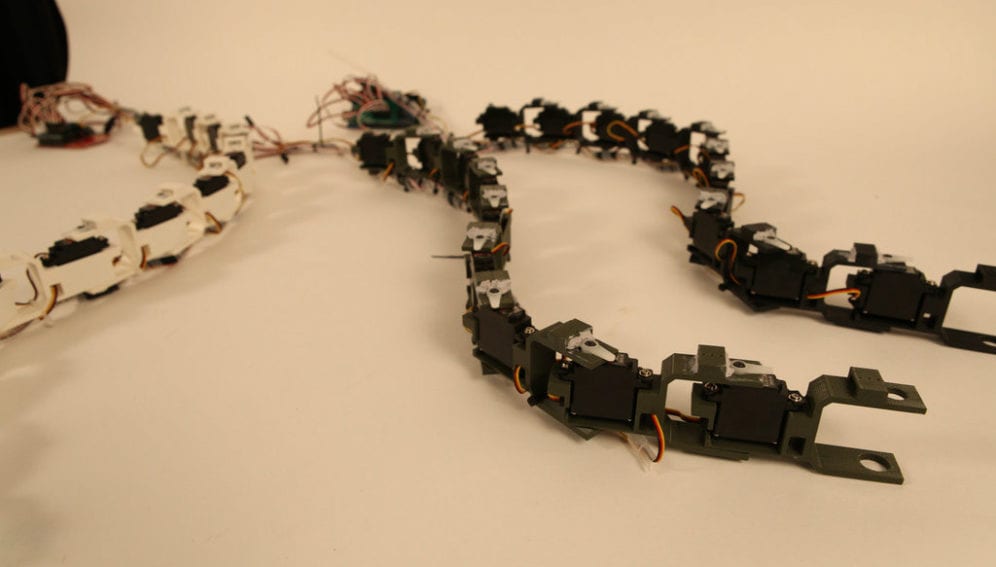By: Joshua Howgego
Send to a friend
The details you provide on this page will not be used to send unsolicited email, and will not be sold to a 3rd party. See privacy policy.
[LAUSANNE, SWITZERLAND] The robotic snakes that US artist and designer Gabriella Levine makes are undeniably funky. The ‘sneel’, as she has dubbed it, is designed to swim into inaccessible environments and collect data with sensors incorporated in its modules.
At the 3rd UNESCO Technologies for Development Conference: What is Essential? conference in Lausanne, Switzerland, this week (3-6 June), I heard Levine speak of how a collective of hardware hackers used the robot to collect radioactivity data in the aftermath of Fukushima when no official data was forthcoming. She also hopes it could be deployed to search for survivors in rubble after disasters in future.
See below for a video about the sneel:
It’s easy to see how the sneel design, which is totally open source, could potentially empower entrepreneurs in the developing world to record their own data in a similar way, especially where a properly functioning government isn’t in place to take on that responsibility.
“The sneel design, which is totally open source, could potentially empower entrepreneurs in the developing world.”
Joshua Howgego
But would it be fair to call these snakes ‘essential’ for development? An odd question, perhaps. But I raise it because that’s the issue this meeting is supposed to be addressing: what technologies are truly vital for development?
It’s not an easy question to answer, so I was intrigued to learn of a project led by Shashi Buluswar, executive director of the Institute for Globally Transformative Technologies at the Lawrence Berkeley National Lab in California, United States, that has tried to answer it empirically.
Buluswar and his colleagues are, in roughly two months, to publish a report entitled The 50 most transformative scientific and technological breakthroughs needed for sustainable global development.
During his talk at the meeting, Buluswar explained that, to form their list, the team began with a huge list of possibilities and ran them through a series of tests to decide which was indispensable. They took into account the biggest causes of problems using quantitative measures such as crop losses (for agriculture) or disability adjusted life years (for health issues), plus they gathered opinions from experts on what interventions were most effective at reducing poverty. They also took into account factors such as how long technological solutions might take to develop, and their dependence on politics, social change, finance and infrastructure.
It was surprising to see what emerged as ‘essential’ after this dispassionate analysis.
For example, Buluswar highlighted one particular technology that I’ve rarely heard discussed in a development setting: a replacement for the Haber-Bosch process that could be used in low-income settings. This is the chemical process that converts nitrogen and hydrogen in the air to ammonia, a crucial component of fertilisers.
Given that they are vastly expensive pieces of chemical infrastructure, “how many Haber-Bosch plants do you think there are in Sub-Saharan Africa?” Buluswar asked delegates. “Zero,” came the answer — which of course means that African farmers pay a premium for imported ammonia, and that dramatically influences farming.
The biggest hurdle to solving this problem is inventing a replacement for the Haber process, Buluswar told the meeting, and that is why he considers it essential. It is indeed an imposing challenge — to make fertiliser from air — and he seemed to be suggesting that for a technology to be considered essential for development, its invention has to be a bigger obstacle than anything else.
Later, with these thoughts in mind, I asked Levine if she would class her robotic snakes as an ‘essential’ technology. She wasn’t about to make overly grandiose claims about her invention. But because her robots are open source, they are a powerful way to engage, educate and empower people to do their own science, she said.
This made me realise that asking whether a technology is ‘essential’ begs the question: essential for what? So I’m looking forward to reading Buluswar’s full list of 50 vital technologies. But even if there are no robot snakes on it, I for one won’t write them off.
Joshua Howgego is SciDev.Net’s deputy news and opinions editor @jdhowgego














